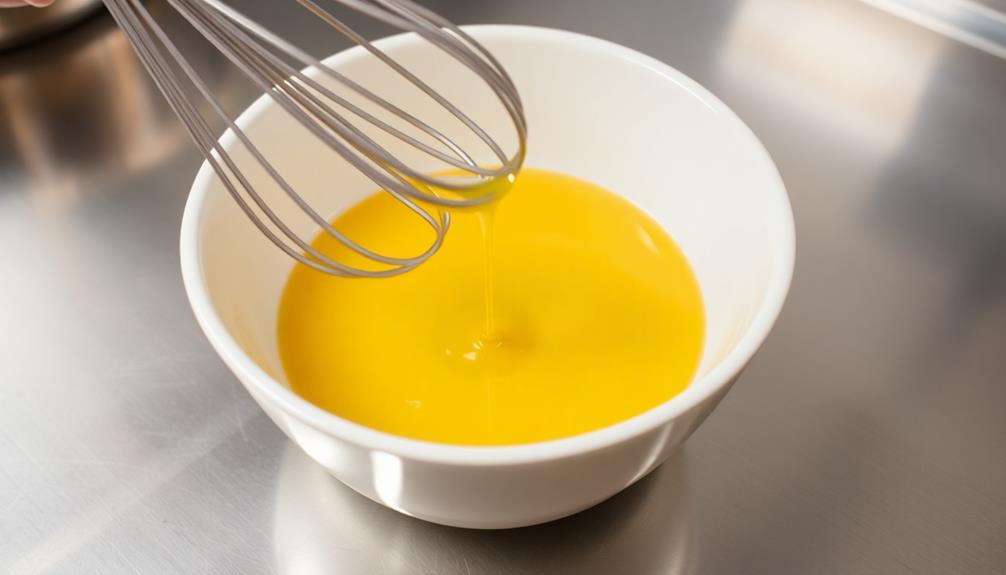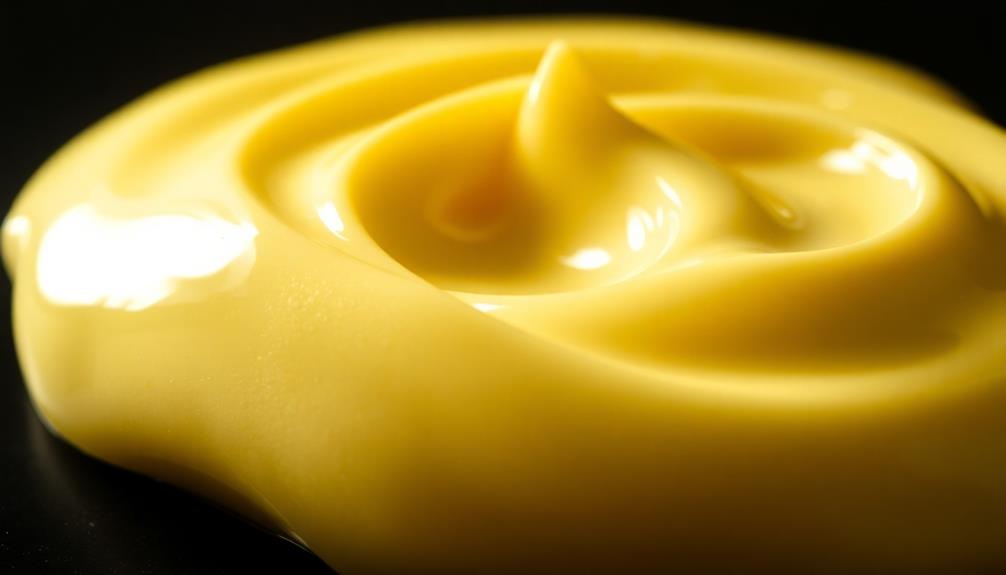Emulsions have long been essential in cooking, dating back to ancient times and marking skilled chefs today. They create stable oil-water mixtures that enhance texture, flavor, and appearance in dishes like vinaigrettes and sauces. Key factors include gradual incorporation, continuous whisking, and temperature control. Proper technique is vital – start ingredients at room temperature, add oil slowly, and maintain an ideal range of 140-180°F. Pay close attention to signs of breakdown, and you'll master creating rich, creamy emulsions. Dive deeper to discover the history, recipes, and troubleshooting tips that elevate your culinary skills.
Key Takeaways
- Emulsions enhance texture, flavor, and appearance of dishes, making them crucial in culinary arts since ancient times.
- Emulsions consist of oil and water mixtures, with common emulsifying agents including egg yolks and mustard.
- Gradual incorporation of oil or water, continuous medium-speed whisking, and temperature control are key techniques for successful emulsions.
- Mayonnaise is a classic example of a stable emulsion created through the gradual addition of oil and whisking.
- Monitoring for signs of breakdown, adjusting temperature, and continuous whisking are essential for maintaining emulsion stability.
History
Emulsions have long been a fundamental component of culinary arts. The history of emulsions can be traced back to ancient civilizations, where cooks discovered that combining oil and water could create smooth, creamy sauces and dressings.
In the 19th century, French chefs began experimenting with emulsions, using techniques like whisking and blending to produce stable mixtures. The development of emulsions was a significant breakthrough in the culinary world.
Emulsions allowed for the creation of dishes with unique textures and flavors, from mayonnaise and hollandaise sauce to vinaigrettes and aioli. As culinary techniques evolved, so too did the understanding of the science behind emulsions.
Chefs and food scientists studied the role of emulsifiers, the effects of temperature, and the importance of proper technique in creating consistently successful emulsions.
Today, the mastery of emulsions remains a hallmark of skilled cooks and chefs, as they continue to push the boundaries of what's possible in the kitchen.
Recipe
Emulsions are an essential component in many culinary creations, and they can be harnessed to create a variety of delectable dishes. One such example is a classic mayonnaise, where the interplay between oil, egg yolks, and acid results in a rich, creamy texture that enhances the flavor of various foods.
Understanding the science behind emulsions can also provide insights into creating balanced meals and textures in family-friendly recipes, such as those suitable for supporting a partner ready for parenthood.
In this recipe, we'll explore how to utilize emulsions to craft a delectable dish that showcases their versatility. By understanding the principles of emulsion formation and stability, you'll be able to unlock new dimensions of flavor and texture in your culinary adventures.
Ingredients:
- 2 large egg yolks
- 1 tablespoon Dijon mustard
- 1 tablespoon white wine vinegar
- 1 cup vegetable oil
- Salt and pepper to taste
Cooking Instructions:
In a medium bowl, whisk together the egg yolks, Dijon mustard, and white wine vinegar until well combined. Gradually, while whisking constantly, slowly drizzle in the vegetable oil, drop by drop at first, until the mixture begins to emulsify and thicken.
Once the emulsion is established, you can gradually increase the rate of oil addition, continuing to whisk vigorously until all the oil has been incorporated and the mayonnaise is thick and creamy. Season with salt and pepper to taste.
Tips:
To ensure a stable emulsion, it's crucial to add the oil slowly, especially at the beginning of the process. This gradual incorporation allows the egg yolks to effectively bind the oil and water components, creating a cohesive and creamy texture.
Additionally, using a fresh, high-quality egg and ensuring all ingredients are at room temperature can contribute to the success of your mayonnaise.
Cooking Steps
Combine the oil and water gradually, taking care to incorporate the emulsifier slowly as you whisk continuously at medium speed.
Adjust the temperature as needed to maintain the emulsion's stability.
Monitor the emulsion closely, making any necessary tweaks to keep it from separating.
Step 1. Combine Oil and Water Gradually

When working with oil and water, it's crucial to take a gradual approach. Combining the two ingredients too quickly can lead to an unstable emulsion, where the oil and water separate. To create a smooth, cohesive emulsion, you'll want to add the oil to the water, or vice versa, in small, steady increments.
Start by adding a small amount of oil to the water, then vigorously whisk or blend the mixture. This agitation helps disperse the oil droplets evenly throughout the water. Gradually increase the amount of oil you add, continuing to mix thoroughly after each addition. The slow, controlled incorporation of the oil prevents the emulsion from breaking down.
Similarly, if you're starting with oil and want to add water, do so in small amounts, blending well after each addition. This gradual approach ensures the water becomes evenly distributed within the oil, creating a stable emulsion that won't separate.
Step 2. Incorporate Emulsifier Gradually

In addition to gradually incorporating the oil or water, using an emulsifier can further stabilize the emulsion. Emulsifiers are substances that help bind the oil and water molecules together, preventing them from separating.
When adding an emulsifier, it's crucial to incorporate it gradually and evenly throughout the mixture. This ensures the emulsifier can efficiently disperse and create a uniform, stable emulsion.
Start by adding a small amount of the emulsifier, such as egg yolks, mustard, or lecithin, and whisk it in thoroughly. As you continue to whisk, gradually increase the amount of emulsifier until you achieve the desired consistency and stability.
Avoid dumping in the entire amount of emulsifier at once, as this can cause the mixture to become overly thick or even break.
Pay close attention to the texture and appearance of the emulsion as you incorporate the emulsifier. A well-emulsified mixture should have a creamy, homogeneous consistency without any signs of separation.
Adjust the amount of emulsifier as needed to reach the perfect balance.
Step 3. Whisk Continuously at Medium Speed

Once you have gradually incorporated the emulsifier, begin whisking the mixture continuously at a medium speed. This constant agitation helps the emulsifier do its job, breaking down the oil droplets and dispersing them evenly throughout the liquid.
Don't be tempted to whisk too vigorously, as this can destabilize the emulsion. The medium speed ensures the emulsifier has enough time to work its magic without creating too much turbulence.
As you whisk, you'll notice the mixture gradually thickening and becoming smoother. This is a good sign that the emulsion is forming properly.
Keep a close eye on the consistency, adjusting the whisking speed if needed to maintain that steady, even texture. Consistent, medium-speed whisking is the key to developing a stable, long-lasting emulsion that will enhance your cooking.
Stick with it, and you'll be rewarded with a silky, emulsified sauce or dressing that holds together beautifully.
Step 4. Adjust Temperature as Needed

The temperature of your emulsion may need to be adjusted as you cook. Maintain a close eye on the mixture and be prepared to tweak the heat as necessary.
If the emulsion starts to separate or the ingredients seem to be breaking down, reduce the temperature. Conversely, if the emulsion appears too thick or sluggish, gradually increase the heat.
Remember, the ideal temperature range is typically between 140°F and 180°F. Adjust in small increments, stirring continuously, to avoid shocking the emulsion.
It's a delicate balance, but with practice, you'll develop a feel for the right temperature to keep your emulsion stable and cohesive.
Don't be afraid to experiment and find the sweet spot for the particular ingredients you're working with. Mastering temperature control is key to crafting perfect emulsions every time.
Step 5. Monitor Emulsion Stability

As you cook the emulsion, it's crucial to monitor its stability closely. Keep an eye on the mixture, looking for any signs of separation or breaking. If the emulsion starts to look grainy or curdled, act quickly to stabilize it.
One way to assess the emulsion's stability is to observe its texture and consistency. A well-emulsified mixture should be smooth, creamy, and homogeneous. If it begins to look thin or watery, it's a sign that the emulsion is starting to break down.
To prevent this, you may need to adjust the temperature or add more emulsifying agent, such as egg yolks or mustard. Gently reheat the mixture, whisking constantly, to help reincorporate the separated components.
If the emulsion remains unstable, you may need to start over, carefully combining the ingredients again.
Monitoring the emulsion's stability is a crucial step in ensuring your dishes have the desired creamy, cohesive texture. By staying vigilant and making timely adjustments, you can maintain a well-emulsified mixture throughout the cooking process.
Final Thoughts
Ultimately, emulsions are a fundamental aspect of cooking that you shouldn't overlook. Understanding how to create and maintain stable emulsions can significantly improve the texture, flavor, and appearance of your dishes.
Whether you're making a creamy vinaigrette, a smooth hollandaise sauce, or a rich and velvety béchamel, mastering emulsion techniques is crucial.
As you've learned, emulsions are delicate and can easily break down. Paying close attention to factors like temperature, agitation, and ingredient ratios is essential to keeping your emulsions intact.
Remember, small adjustments can make a big difference, so don't be afraid to experiment and find what works best for your specific recipes and techniques.
Ultimately, embracing the science of emulsions in your cooking will unlock a world of culinary possibilities. With a deeper understanding of these fundamental principles, you’ll be able to create more consistent, versatile, and enjoyable dishes that will impress your family and friends. By understanding how emulsions work, you can also better control the texture and mouthfeel of your dishes, leading to a truly elevated dining experience. Additionally, knowledge of emulsions can help you make better use of heat transfer methods, such as incorporating different fats and oils to achieve the perfect sear on a steak or the ideal flakiness in a pastry crust. This deeper understanding will not only improve the quality of your cooking but also enhance your overall culinary skills.
Frequently Asked Questions
How Long Can the Emulsion Remain Stable Before Breaking Down?
The stability of the emulsion depends on various factors, but it can typically remain stable for anywhere from a few minutes to several hours before breaking down if the proper techniques are used.
Can I Substitute Certain Ingredients to Create Different Flavor Profiles?
You can absolutely substitute ingredients to create different flavor profiles! While the emulsion may not be as stable, experimenting with new combinations can yield delicious results. Just be mindful of how the substitutions may affect the overall texture and balance.
What Factors Affect the Shelf-Life of the Emulsified Mixture?
The shelf-life of an emulsified mixture depends on factors like the type of emulsifier, pH, temperature, and storage conditions. These can affect the stability and prevent separation or spoilage, ensuring your creation stays fresh longer.
How Can I Troubleshoot Common Issues With Emulsion Formation?
To troubleshoot common issues with emulsion formation, consider the ratio of ingredients, mixing technique, and temperature. Adjust these factors, and you'll be able to create a stable, well-blended emulsion in no time.
Can I Use This Technique to Create Emulsions for Non-Food Applications?
You can absolutely use emulsion techniques for non-food applications. The principles of emulsion formation apply to various industries, from cosmetics to industrial products. Experiment with different oil-water combinations and emulsifiers to create stable, customized emulsions for your specific needs.










